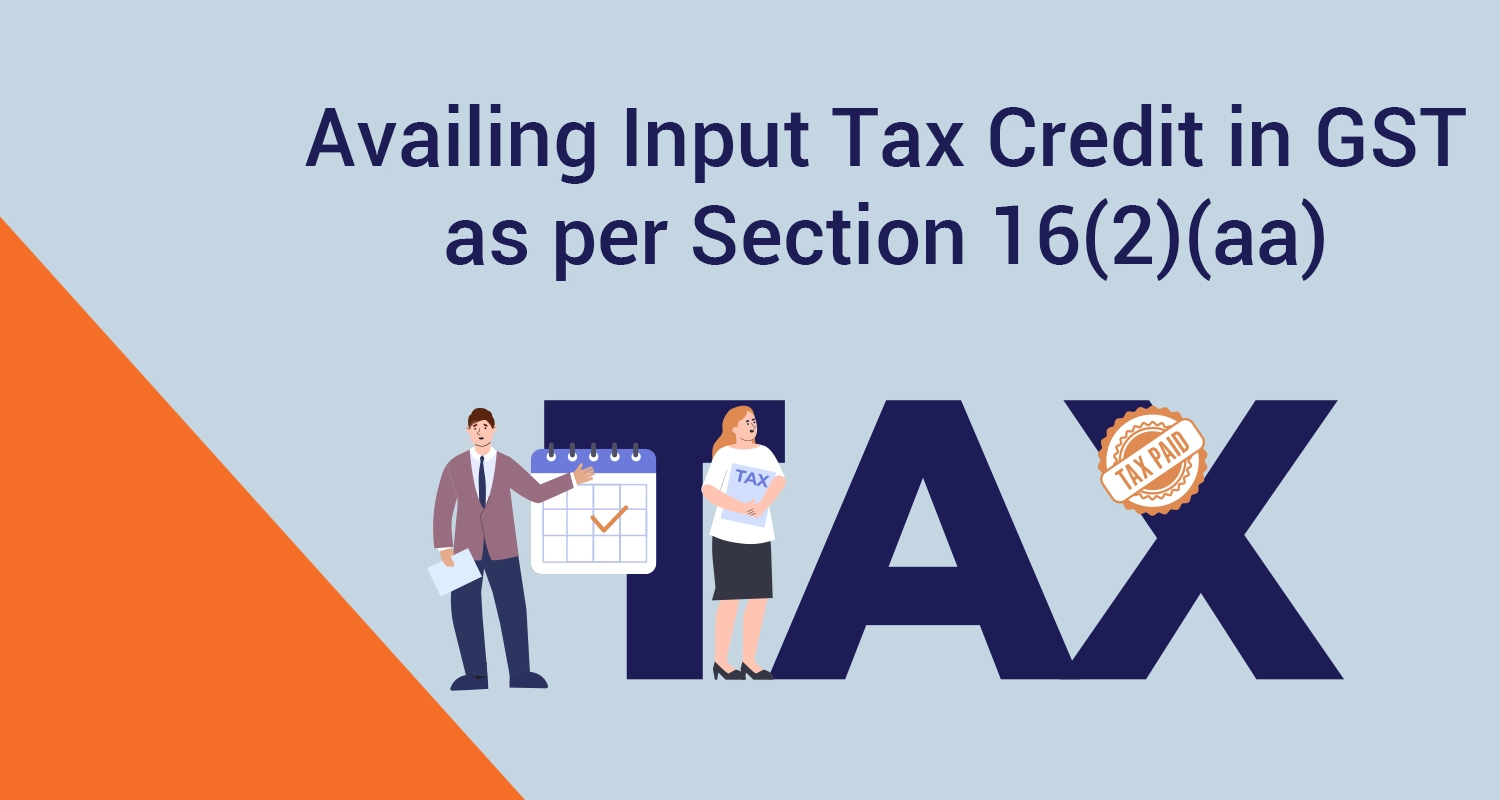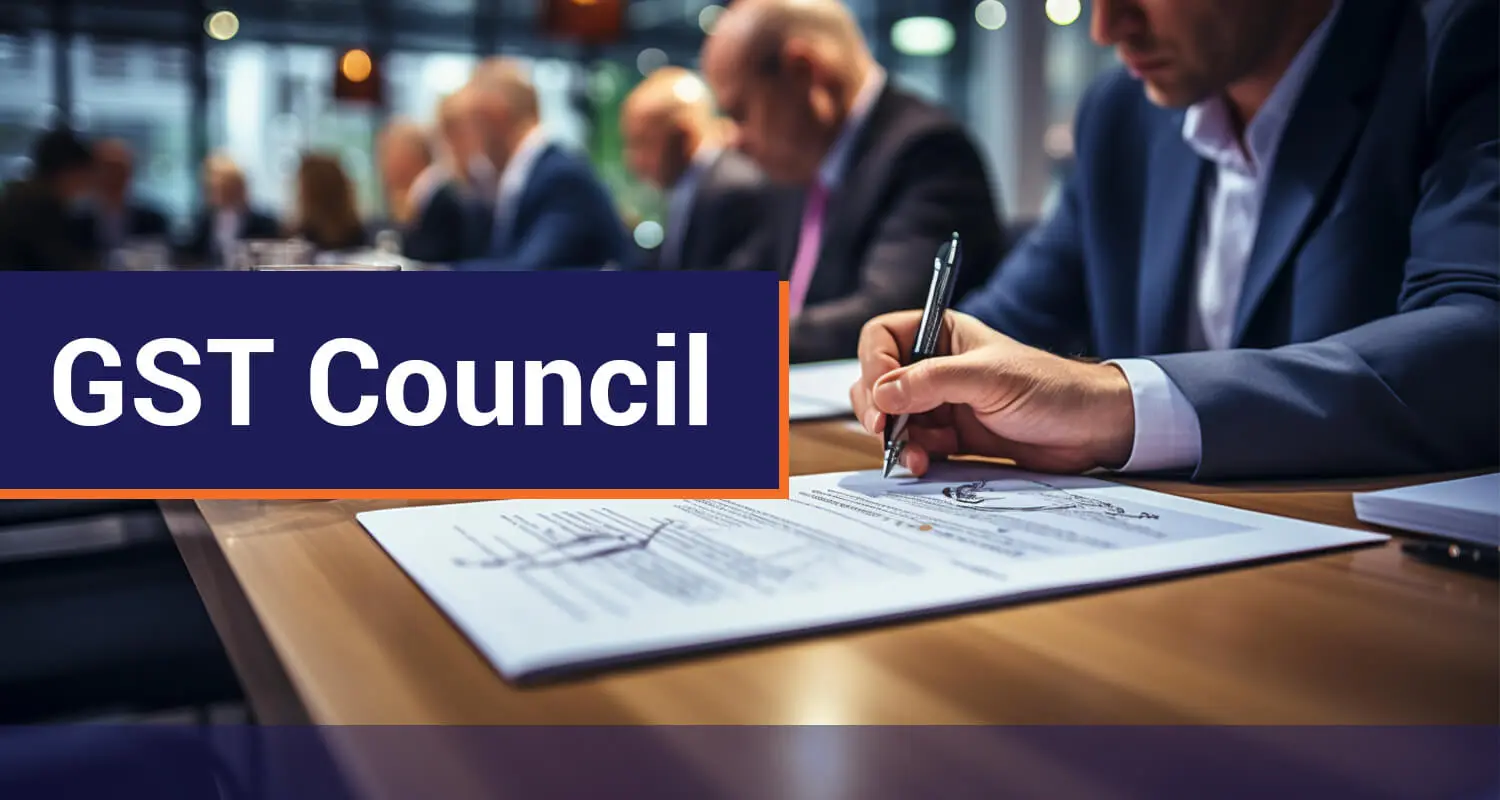Avail ITC in GST as per Section 16(2)(aa)

Since its inception in 2017, GST has been a complex road for taxpayers, especially for new businesses trying to comprehend its regulations and compliance. The journey to master GST's intricacies is often punctuated by new updates that can be confusing. However, these changes are designed to enhance the system. In 2022, significant amendments to GST laws were rolled out, including a new clause in Section 16(2) of the Central Goods and Services Tax (CGST) Act and the imposition of restrictions on the provision of Input Tax Credit (ITC). This article delves into these amendments, shedding light on their implications for the Input Tax Credit.
What is an Input Tax Credit?
ITC is the tax that a buyer in business pays on the purchases made. This amount is later used to reduce the business's tax liability when it makes a sale. This means businesses can lower their overall tax liability by claiming credit (ITC) for the GST paid on purchases.
Here's an example:
Mr.A bought goods worth Rs.18,000 with GST at 18%, which is Rs.3240. He sold goods worth Rs.22,000, with an 18% GST of Rs.3960. Now, the net GST payable will be-
Outward GST payable = Rs.3960
Less GST paid on purchases = (Rs.3240)
Net GST payable in cash = Rs.720
Here, the Rs.3240 input tax credit reduces the tax paid on purchases.
All three Acts—CGST, SGST, and IGST—allow ITC. Credit from all three can be used for IGST liability. However, only IGST and CGST credits can be used under the CGST Act, and only IGST and SGST credits can be used under the SGST Act. So, if the concept is this simple, what makes claiming ITC a complex procedure?
Sapna aapka. Business Loan Humara.
Apply NowConditions to avail of the ITC under Section 16 of The CGST Act (Preamendment):
Section 16(2) of the CGST Act outlines the conditions for recipients of goods or services in sale to claim ITC in their returns. According to this provision, a registered person can claim ITC if:
- They possess tax documents like tax invoices, debit notes, or other documents issued by the registered vendor or supplier.
- They have received or are deemed to have received goods or services.
- They have paid the tax mentioned on the invoice to the government, either in cash or by utilising the accrued ITC from previous transactions.
- They have filed the return for the tax period (financial year).
If these conditions are not met, the recipient cannot claim ITC. Additionally, there are specific cases where you cannot claim ITC. The exclusions include (but are not limited to):
- For composite dealers.
- On the purchase of capital goods for non-business purposes.
- On the purchase of capital goods for manufacturing exempted goods.
- Blocked credits.
- Purchases for private use.
- Purchases for constructing immovable property for personal or business use.
- Motor vehicles whose seating capacity is less than 13, leasing, renting, or hiring motor vehicles.
- Purchases of food and beverages, catering, health services, plastic surgery, etc.
What amendment was introduced?
Recently, the Central Board of Indirect Taxes, through notification no.39/2021 dated December 21, 2021, amended the Finance Act 2012. This amendment added clause (aa) to Section 16(2) of CGST Act.
So the scenario is-
- Before the amendment, vendors or suppliers had to include invoices in their GSTR-1. These were then auto-populated in the recipient's GSTR-2A. The recipient could claim ITC based on these entries. Another rule allowed claiming a percentage of ITC even if the supplier in GSTR-1 did not upload some invoices.
- After the amendment, there is a stricter condition for availing ITC. To avail of ITC, a registered person must ensure the invoice is reflected in their GSTR-2B. This means the invoice details must be reported by the supplier in their outward return and communicated to the recipient as per Section 37 of the CGST Act. This adds another step for claiming ITC, ensuring that the supplier's reported invoice matches the recipient's records.
So now, GSTR-2A and GSTR-2B are two auto-generated GST returns related to this amendment. GSTR-2A gets updated in real-time as the vendor updates GSTR-1. GSTR-2B is a static return generated after the vendor files GSTR-1. Both returns help reconcile ITC data. So now, you must reconcile ITC data with 2A and 2B before claiming ITC for that month.
Why was the amendment introduced?
- Ensure Compliance: The amendment regulates the compliance of every invoice in the GST chain.
- Provisional ITC Removal: Previously, taxpayers could wait until the return filing due date to address missing or mismatched invoices with vendors. If corrections were made, it was beneficial, but if not, provisional ITC (5%) was claimed, leading to a lax approach.
- Continuous Communication: After the amendment, provisional ITC is no longer available. Communication between the vendor and recipient must be constant and channelled through GSTR 2B to claim ITC.
- Vendor Supervision: Recipients must also monitor and maintain contact with non-compliant vendors, as such vendors impact their ITC claims.
What are the consequences of the amendment?
- Recipients must now meet new responsibilities to obtain ITC, which can get time-consuming and inconvenient.
- A constant communication channel must be compulsorily maintained between the vendor and recipient to ensure vendor compliance.
- Non-compliance with the new conditions can result in penalties or the suspension of the recipient company's GSTIN.
- Delays in addressing ITC claims can harm businesses' cash flow and working capital.
Conclusion
Input Tax Credit has been crucial in the GST regime, helping businesses settle their tax liabilities. Though the complexities have increased with the introduction of the amendment, it has resulted in a more robust system of claiming ITC. As a taxpayer, you must now ensure your vendors file returns correctly and upload invoices to reconcile data in GSTR-1 and GSTR-2A to avail ITC. This new requirement is challenging and time-consuming. Due to this, you may need expert advice or professional help to navigate these complexities.
FAQs
Q1. What is the time limit to claim the input tax credit under GST Section 16(2)?Ans. The time limit for claiming ITC against an invoice (or a debit note) is the earlier of the following two-
- 30th November of the next FY (financial year)
- Or the date of filing GSTR-9 (annual returns) for that financial year
It is important to note that for debit notes, consider the above condition with respect to the debit note itself, not the original invoice. This means that if a debit note is issued later to adjust the amount payable on an original invoice, the timeline for claiming ITC is determined from the debit note date.
Q2. Who is eligible to claim ITC under GST?Ans. You can claim ITC if your business is registered under GST and you have filed the GSTR-2 form.
Q3. What is form GSTR-3B?Ans. Form GSTR-3B is a simplified summary return. It lets you declare your GST liabilities for a specific tax period and settle these liabilities.
Sapna aapka. Business Loan Humara.
Apply NowDisclaimer: The information contained in this post is for general information purposes only. IIFL Finance Limited (including its associates and affiliates) ("the Company") assumes no liability or responsibility for any errors or omissions in the contents of this post and under no circumstances shall the Company be liable for any damage, loss, injury or disappointment etc. suffered by any reader. All information in this post is provided "as is", with no guarantee of completeness, accuracy, timeliness or of the results etc. obtained from the use of this information, and without warranty of any kind, express or implied, including, but not limited to warranties of performance, merchantability and fitness for a particular purpose. Given the changing nature of laws, rules and regulations, there may be delays, omissions or inaccuracies in the information contained in this post. The information on this post is provided with the understanding that the Company is not herein engaged in rendering legal, accounting, tax, or other professional advice and services. As such, it should not be used as a substitute for consultation with professional accounting, tax, legal or other competent advisers. This post may contain views and opinions which are those of the authors and do not necessarily reflect the official policy or position of any other agency or organization. This post may also contain links to external websites that are not provided or maintained by or in any way affiliated with the Company and the Company does not guarantee the accuracy, relevance, timeliness, or completeness of any information on these external websites. Any/ all (Gold/ Personal/ Business) loan product specifications and information that maybe stated in this post are subject to change from time to time, readers are advised to reach out to the Company for current specifications of the said (Gold/ Personal/ Business) loan.



